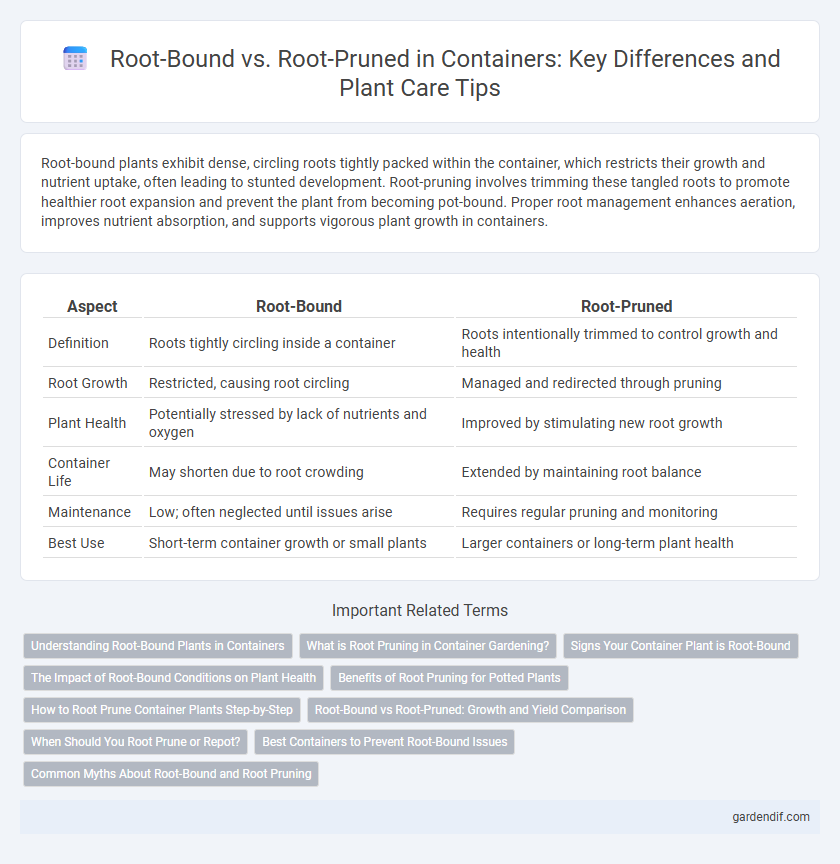
Root-bound vs root-pruned Illustration
Root-bound plants exhibit dense, circling roots tightly packed within the container, which restricts their growth and nutrient uptake, often leading to stunted development. Root-pruning involves trimming these tangled roots to promote healthier root expansion and prevent the plant from becoming pot-bound. Proper root management enhances aeration, improves nutrient absorption, and supports vigorous plant growth in containers.
Table of Comparison
| Aspect | Root-Bound | Root-Pruned |
|---|---|---|
| Definition | Roots tightly circling inside a container | Roots intentionally trimmed to control growth and health |
| Root Growth | Restricted, causing root circling | Managed and redirected through pruning |
| Plant Health | Potentially stressed by lack of nutrients and oxygen | Improved by stimulating new root growth |
| Container Life | May shorten due to root crowding | Extended by maintaining root balance |
| Maintenance | Low; often neglected until issues arise | Requires regular pruning and monitoring |
| Best Use | Short-term container growth or small plants | Larger containers or long-term plant health |
Understanding Root-Bound Plants in Containers
Root-bound plants in containers exhibit tightly packed roots circling the pot's edges, restricting nutrient and water absorption and leading to stunted growth. Root pruning, a horticultural practice involving trimming these congested roots, encourages healthier development by stimulating new root growth and improving soil aeration. Recognizing root-bound symptoms, such as reduced vigor and visible root circling, is essential for timely root pruning and optimal container plant health.
What is Root Pruning in Container Gardening?
Root pruning in container gardening involves trimming the roots of a plant to promote healthy growth and prevent it from becoming root-bound. This technique helps maintain the root system's balance by encouraging new root development and improving nutrient absorption. Regular root pruning extends the lifespan of plants in containers and enhances overall plant health.
Signs Your Container Plant is Root-Bound
Visible signs your container plant is root-bound include roots circling tightly around the pot edges, poor water absorption causing frequent wilting, and slowed growth despite adequate care. Yellowing leaves and soil that dries out rapidly also indicate restricted root space, limiting nutrient uptake. Address root-bound symptoms by repotting into a larger container or gently pruning the roots to encourage healthy expansion and improved plant vigor.
The Impact of Root-Bound Conditions on Plant Health
Root-bound conditions occur when a plant's roots grow densely within a limited container space, restricting nutrient and water uptake essential for growth. This stress often leads to reduced plant vigor, yellowing leaves, and stunted development, impairing overall health and productivity. In contrast, root-pruned plants benefit from controlled root growth, promoting fresh root development and improving nutrient absorption, which enhances plant resilience and vitality.
Benefits of Root Pruning for Potted Plants
Root pruning in potted plants promotes healthier root systems by preventing root-bound conditions, which often cause stunted growth and poor nutrient absorption. Regular root pruning enhances aeration and encourages the development of fine feeder roots, improving water and nutrient uptake efficiency. This practice extends the longevity of container plants, supports vigorous growth, and reduces transplant shock.
How to Root Prune Container Plants Step-by-Step
Root pruning container plants involves carefully trimming circling or dense roots to promote healthy growth and prevent root-bound conditions. Begin by removing the plant from the container, gently loosening the root ball, then use clean, sharp scissors or pruning shears to cut away up to one-third of the outer roots, focusing on circling and excessively long roots. Repot the plant with fresh soil, ensuring adequate water and nutrients to support recovery and encourage new root development.
Root-Bound vs Root-Pruned: Growth and Yield Comparison
Root-bound plants exhibit restricted growth due to densely packed roots circling the container, limiting nutrient uptake and reducing overall yield. Root-pruned plants experience enhanced root development and better nutrient absorption after trimming, promoting healthier growth and increased biomass production. Comparatively, root-pruned containers support improved plant vigor and higher harvest quality versus the stunted outcomes typical of root-bound conditions.
When Should You Root Prune or Repot?
Root pruning is beneficial when plants have outgrown their containers but still have healthy root systems that require stimulation to promote new growth, typically every 1-2 years for fast-growing species. Repotting becomes necessary when roots are excessively root-bound, causing restricted nutrient uptake and poor drainage, commonly observed in plants with circling roots or tightly packed soil. Timing these interventions in spring or early growing seasons ensures optimal recovery and sustained plant health.
Best Containers to Prevent Root-Bound Issues
Choosing the best containers such as air-pruning pots and fabric grow bags significantly reduces root-bound problems by promoting natural root pruning, which encourages healthier root systems and prevents circling roots. Containers with well-drained, breathable materials enable oxygen to reach the root zone, enhancing root growth and nutrient uptake. Selecting containers with these features supports vigorous plant development and avoids the common pitfalls associated with root-bound conditions.
Common Myths About Root-Bound and Root Pruning
Root-bound plants do not always suffer from growth problems; many species tolerate crowded roots without decline. Root pruning encourages new root growth but must be done carefully to avoid stress and stunted development. Common myths suggest root-bound plants always need re-potting and root pruning always harms plants, yet proper assessment of root health is essential for container gardening.
Root-bound vs root-pruned Infographic

 gardendif.com
gardendif.com